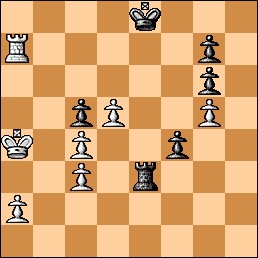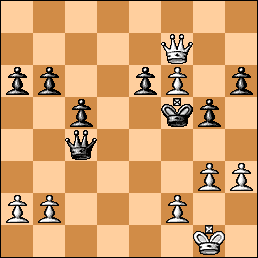Preamble: The US Junior Open 1974
The first time I met Yasser Seirawan it was August 1974 at the Franklin & Marshall College in rural Lancaster, Pennsylvania, site of the 1974 US Junior Open. This tourney, full of nascent stars such as Michael Rohde and John Fedorowicz (and yes, Steve Odendahl) was won by obscure New Mexico master Spencer Lucas whose specialty, as I recall, was the Alekhine’s Defense. This was my first chess trip out of town (I hailed from Bethesda, MD) and Greyhound Bus Lines lost my luggage for the duration of the event.
MG Addendum 5/14/08: Dana MacKenzie writes that Yasser was “the top-rated player […] a 14-year-old with a rating of 2315. […] I never got within a mile of playing on the top boards, but I still remember this player’s calm, unflappable demeanor. He had curly hair and an angelic face that looked rather girlish, but I doubt that anybody teased him about it in this crowd, because nobody teases the #1 guy in the tournament.”
I don’t think Yasser’s rating was that high in Lancaster. Readers will need to check this. Yasser was a very peppy kid, on the small side, but I don’t think he was the pre-event favorite. In fact, I remember Spencer Lucas, a low master, as having a stratospheric rating.
Oddities from the 1974 Junior Open Tournament
In one bizarre turn of events, Fedorowicz lost to a kid dressed in a burlap sack (because John forgot where he was going to move after a long break brought on by President Nixon resigning; TD Leroy Dubeck ordered everyone’s clocks stopped for quite a while!). In another oddity, young Phil (Flippy) Goulding from Maryland castled queenside illegally vs Michael Rohde (a black knight on b2(!) covered the d1 square!), said “J’adoube” very audibly, uncastled, then moved his King to a random square, remaining two pawns down as white and dead lost in an Alekhine’s. Flippy drew that game after the shocking un-castle (and almost won it).
Yasser was a small yet energetic kid with a big afro who would jump up and exclaim “Hi-yer, I’m Yass-er!” Flash forward 4 years and we find ourselves in a much more serious event.
Flash Forward 4 Years to 1978
It’s now August 1978 and US Junior Championship Invitational in Memphis, TN. One of the big Kahunas was the unflappable and dapper (and much more grown-up!) Yasser Seirawan from Seattle. With a towering 2452 rating, he was indeed the one to beat. When the game started, we were both at “plus one” and needed to move up.
Yasser is third from left; I am second from right. Click to enlarge.
Mark Ginsburg (2339) – Yasser Seirawan (2452)
US Junior Invitational 1978, Round 4 40/150 then adjournment
English Opening
1. c4 Nf6 2. Nc3 e6 3. e4!? d5 3…c5 4. e5 Ng8 is a whole different story. In any event, it’s good psychology to make a player face his own favorite opening – Yasser has scored numerous impressive wins with the English.
4. e5 d4 5. exf6 dxc3 6. bxc3 Qxf6 7. d4 The inversion 7. Nf3! with the idea of e.g. 7…c5 Bd3!? 9. O-O Bd6 10. Be4! with an edge, as in Ginsburg-Somogyi Las Vegas 2005, was not known yet. Also see 7. Nf3 e5 8. Bd3! and white won a nice quick game in Nakamura-Zarnicki, Minneapolis 2005.
7…b6 8. Nf3 In some game from Yasser’s early career, I believe he was successful playing white with the offbeat 8. Nh3!?
7…Bb7 9. Be2 Bd6 10. Qa4+ Bc6 11. Qc2 (0:37) Qg6!
Yasser defuses my harmless 10th and 11th moves and gets the queens off.
12. Qxg6 hxg6 13. Be3 Nd7 14. O-O-O Bb7 (0:29) 15. h3 The position is about equal.
15…c5!? (0:41) A risky strategic commitment. White gladly advances with d4-d5 and black has no chance to bother white’s shielded c-pawns. In addition, white will gain a lot of space on the kingside. 15…O-O or 15…a6 are safe.
16. d5 e5 Perfectly playable is 16…exd5 17. cxd5 Nf6 18. Bb5+ Kf8 19. c4 Rc8. The text is fine too; it just leads to a more blocked position.
17. Ng5 f5? (1:04) Correct is 17…Nf6 and it’s about level.
18. f3 Very strong is 18. g4! right away. 18…f4 19. Bd2 b5 20. Rhe1 and white is better. The slow text is still a bit better for white.
18…Nf8 19. Bd3 Bc8 20. Rde1 Ke7 21. h4 Bd7 22. Re2 Again, 22. g4 is strong.
22…Nh7! 23. Nxh7 Rxh7 24. Bg5+ Kf7 Black is all right again.
25. g4 (1:34) Rhh8 Perfectly reasonable is 25… Rf8 26. Rg2 Be7 and black holds.
26. h5 Rae8?! More accurate is 26… Raf8 27. Rg2 gxh5 28. gxh5 Rh7. Also, 26…gxh5 is fine for black.
27. Rg2 Kf8? Relatively best is 27… gxh5 28. gxf5! with a small white advantage.
28. h6! Kf7? Black must have been totally confused by white’s unusual space gaining ‘pawn storm’. More challenging is 28… gxh6 29. Bxh6+ or 29. Rxh6, in both cases with a white edge but nothing decisive yet.
29. h7! (1:56) Now white has a winning bind! It’s quite unusual for a master strategist such as Yasser to fall behind strategically, but that is what happened. Only white can ruin his own game now – I have a free rein on all sides of the board.
29…Be7 30. Bxe7 Rxe7 31. Bc2 Kf6 32. Kd2 The immediate 32. g5+ Kf7 33. Kd2 Ree8 34. Re2 b5 35. Bb3 a6 36. Kd3 bxc4+ 37. Bxc4 Bb5 38. a4 Bxa4 39. Bxa6 is quite winning.
32… f4 33. g5+ Kf7 34. Re2 Be8 (2:15) 35. Kc1 Kf8 36. Kb2 Kf7 There is nothing for black to do but sit and wait for the axe to fall. Seirawan himself has won many games tying his opponent up hand and foot.
37. Ka3 Bd7 38. Ba4 Ke8 39. Rhe1 Rxh7 40. Rxe5 Rxe5 41. Rxe5+ Kd8 42. Bxd7 Kxd7 (2:35) The sealed move. Yes, we had dinner-break adjournments in the 1970s. Black’s position is completely hopeless.
43. Re4! (2:29) More accurate than 43. Re6 Rh3.
43… Rh4 44. Ka4 a6
45. Re6 Winning is the fairly obvious 45. a3 and black has no move left (zugzwang). For example, 45…Rh5 46. Rxf4 Rxg5 47. Rf7+ Kc8 48. Rxg7 Rg3 49. Kb3 g5 50. a4 Kb8 51. a5 bxa5 52. Ka4 Rxf3 53. Kxa5 Rf6 54. Rxg5 Kc8 55. Rg7 Kb8 56. Re7 Rf3 57. Kxa6 Rxc3 58. Kb6 and wins. The text is winning too. It’s very hard to see how white could not win this.
45… Rh3 46. Rxb6 46. Rxg6 is also winning: Rxf3 47. Rxg7+ Kd6 48. Rg6+ Kc7 49. Rf6 Rg3 50. g6 f3 51. kb3 f2 52. Rxf2 Rxg6 53. Rf7+ Kb8 (53…Kd6 54. Ra7 wins) 54. a4 threatening a5.
46…Rxf3 47. Rxa6 Re3 47… Rxc3 48. Ra7+ Ke8 49. d6 Rd3 50. Re7+ Kf8 51. Re4 Rd4 52. d7 Rxd7 53. Rxf4+ Ke7 54. Kb5 wins. When this game was played, I believed the text 47…Re3 to be some kind of ingenious resource and I started to get nervous, which is ridiculous of course.
48. Ra7+! White doesn’t fall for the trick 48. Rxg6 Re7! and the f-pawn is a major nuisance. It should be all over now.
48…Ke8 Black, as a Harvard freshman once wrote in a political science essay, “is at the very brink of Agamemnon.”
49. Ra8+?? This is one of those moments where I look at the old scoresheet and cannot believe what I am reading. One of the “issues” was that I went out with Fedorowicz during the adjournment break and Yasser stayed inside, “working”. But of course there’s nothing to work on. In any event, if I had even briefly looked at the adjournment, I would have not gone up this blind alley and played the obvious 49. Rxg7 f3 50. Rxg6 and black can resign, for example 50…Rxc3 51. Kxb5 and the game is over. Believe it or not, I had not calculated the capture on move 50, believing my opponent’s f-pawn would be a problem in this variation. Since it is not, (pawn g5 guards Rf6 to stop the enemy pawn), white just wins with the numerous extra pawns. The text draws!
49… Ke7 What a gruesome turn of events. Now black’s f-pawn really is a problem! The rest of the game is simply white flailing around trying to win an unwinnable game. What an incredible botch!
50. Ra7+ Ke8 51. Rb7 f3 52. Rb1 Kd7 53. Kb3 f2 54. Rf1 Re2 55. a4 Kc7 56. a5 Rd2 57. Ka4 Rb2 58. Rd1 Re2 59. Rf1 Rb2 60. Ka3 Rd2 61. Kb3 Kb7 62. Ka4 Ka6 63. d6 Ra2+ 64. Kb3 Rd2 65. d7 Rxd7 66. Rxf2 Kxa5 67. Re2 Rb7+ 68. Kc2 Rb6 69. Re7 Rc6 70. Rxg7 Re6 71. Kd3 Ka4 72. Rd7 Kb3 73. Rb7+ Ka3 74. Rd7 Kb3 75. Rd5 Rc6 76. Rd8 Re6 77. Rb8+ Ka3 78. Kc2 Re2+ 79. Kd3 1/2-1/2
It was very ignominious to have to face the rest of the players the next day and offer fumbling explanations regarding the half point on the crosstable.
In Part II, we’ll examine another “bring Yasser back from the precipice”, World Open 1984, where my position was just as winning. D’oh!













